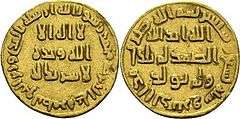Dinar

The dinar or denar is a main currency unit in modern circulation in seven mostly-Islamic and two mostly-Orthodox (Serbia and FYRM) countries, and has historic use in several more.
History

The English word "dinar" is the transliteration of the Arabic دينار (dīnār), which was borrowed via the Syriac dīnarā from the Greek δηνάριον (denárion), itself from the Latin dēnārius.[1][2] The gold dinar was an early Islamic coin corresponding to the Byzantine denarius auri.[3] A gold coin known as the dīnāra was also introduced to India by the Kushan Empire in the 1st century AD, and adopted by the Gupta Empire and its successors up to the 6th century.[4][5] The modern gold dinar is a modern bullion gold coin.
Legal tender
Countries currently using a currency called "dinar" or similar

| Countries | Currency | ISO 4217 code |
|---|---|---|
| |
Algerian dinar | DZD |
| |
Bahraini dinar | BHD |
| |
Iraqi dinar | IQD |
| |
Jordanian dinar | JOD |
| |
Kuwaiti dinar | KWD |
| |
Libyan dinar | LYD |
| |
Macedonian denar | MKN (1992–1993) MKD (1993− ) |
| |
Serbian dinar | RSD |
| |
Tunisian dinar | TND |
Countries and regions which have previously used a currency called "dinar"

| Countries | Currency | ISO 4217 code | Used | Replaced by |
|---|---|---|---|---|
| Bosnia and Herzegovina dinar | BAD | 1992–1998 | Bosnia and Herzegovina convertible mark | |
| Croatian dinar | HRD | 1991–1994 | Croatian kuna | |
| Iranian rial was divided into at first 1250 and then 100 dinars | ||||
| Republika Srpska dinar | n/a | 1992–1998 | Bosnia and Herzegovina convertible mark | |
| South Yemeni dinar | YDD | 1965–1990 | Yemeni rial | |
| Sudanese dinar | SDD | 1992–2007 | Sudanese pound | |
| Yugoslav dinar | YUD (1965–1989) YUN (1990–1992) YUR (1992–1993) YUO (1993) YUG (1994) YUM (1994–2003) | 1918–2003 | n/a | |
The 8th century English king Offa of Mercia minted copies of Abbasid dinars struck in 774 by Caliph Al-Mansur with "Offa Rex" centered on the reverse.[6][7] The moneyer visibly had no understanding of Arabic as the Arabic text contains many errors. Such coins may have been produced for trade with Islamic Spain.
See also
- Currency
- Economy of the Organisation of Islamic Cooperation
- Islamic gold dinar
- Kelantanese dinar
- List of circulating currencies
- Middle East economic integration
References
| Wikimedia Commons has media related to Dinars. |
- ↑ Oxford English Dictionary, Second edition, 1989, s.v. dinar; online version November 2010
- ↑ Versteegh, C. H. M.; Versteegh, Kees (2001). The Arabic Language. Edinburgh University Press. p. 60. ISBN 978-0-7486-1436-3.
- ↑ Koehler, Benedikt (2014). Early Islam and the Birth of Capitalism. Lexington Books. p. 102. ISBN 978-0-7391-8883-5.
- ↑ Friedberg, Arthur L.; Friedberg, Ira S. (2009). Gold Coins of the World: From Ancient Times to the Present. Coin & Currency Institute. p. 457. ISBN 978-0-87184-308-1.
- ↑ Mookerji, Radhakumud (2007). The Gupta Empire. Motilal Banarsidass. pp. 30–31. ISBN 978-81-208-0440-1.
- ↑ British Museum
- ↑ Medieval European Coinage By Philip Grierson p.330
- Krause, Chester L.; Clifford Mishler (2003). 2004 Standard Catalog of World Coins: 1901–Present. Colin R. Bruce II (senior editor) (31st ed.). Krause Publications. ISBN 0873495934.
- Malaysia: Kelantan collects Zakat in Shariah money